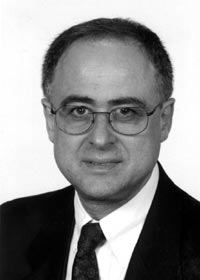Dr. Mostafa Kaveh
Centennial Chair Professor and Head
Dept. of Electrical and Computer Engineering, University of Minnesota
BSEE 1969, PhD 1974

As a young man in 1966, Mostafa Kaveh left his native Iran to attend Purdue University, basing his decision, he says, "on Purdue’s high international reputation for engineering education in general, and electrical engineering in particular." He was admitted to the research and development option, a sort of honors program. "More importantly," Kaveh, remembers, "I was fortunate to meet my wife at Purdue."
A fellowship from the University of California at Berkeley attracted him to California where he completed his MS degree in 1970, working in the area of solid state devices. "Following the birth of our daughter, I spent a year working at the Scala Radio Corporation of San Leandro before returning to Purdue to pursue a PhD," he recalls. The industrial experience and the emergence of biomedical engineering as a discipline reoriented his interests to both communications and biomedical instrumentation. He worked with Vernon Newhouse on ultrasound blood flow measurement and under the supervision of George Cooper for his PhD dissertation. During this period, Kaveh also worked on the redesign of the Purdue Random Signal Radar. "I spent considerable time on the roof of the EE building trouble-shooting the antenna’s drive circuits," he says.
After the completion of his dissertation in 1974 and postdoctoral research in image restoration with Thomas Huang, Kaveh joined the faculty at the University of Minnesota where, since 1990, he has served as the head of the Department of Electrical and Computer Engineering and holds the Centennial Chair in Electrical Engineering. Under his leadership, the computer engineering degree program was established, the Department name was changed from EE to ECE, and department research and endowment funds have grown substantially. "As the head, I have continued to teach every year at both undergraduate and graduate levels and to coordinate our senior honors program," he says. "I have also continued my research program, which most recently has concentrated in the area of wireless communications." He believes the cross-disciplinary nature of his research experience at Purdue has characterized his work as a faculty member.
Kaveh’s research and teaching contributions include a wide range of subjects in signal processing, image processing, ultrasonic imaging, sensor array processing and wireless communications. "As a mentor, I am, of course, indebted to the contributions of my former students, and am proud of their professional accomplishments in academia and industry."
Kaveh was elected to the status of Fellow of IEEE for his work in the area of diffraction tomography, a technique that he and colleague Rolf Mueller developed for ultrasonic imaging of soft tissue. He was awarded the 2000 Society Award by the IEEE Signal Processing Society for work in the area of statistical array processing.
Kaveh and his wife Carol, a 1969 Purdue graduate with a BA in French Language, have two children. Their daughter, Ana, is a biologist and program supervisor of the Human Body Gallery at the Science Museum of Minnesota. Their son, Dari, will be a freshman this year at the University of Minnesota.
When recalling his Purdue experience, Kaveh says, "The genius of American higher education has been its welcoming attitude and the opportunities it has provided to students and scholars from around the world. Science and engineering have been particular beneficiaries of such an intellectual melting pot, and industry has thrived from the resulting creative and entrepreneurial diversity. This global meeting of minds is worth celebrating and supporting."
